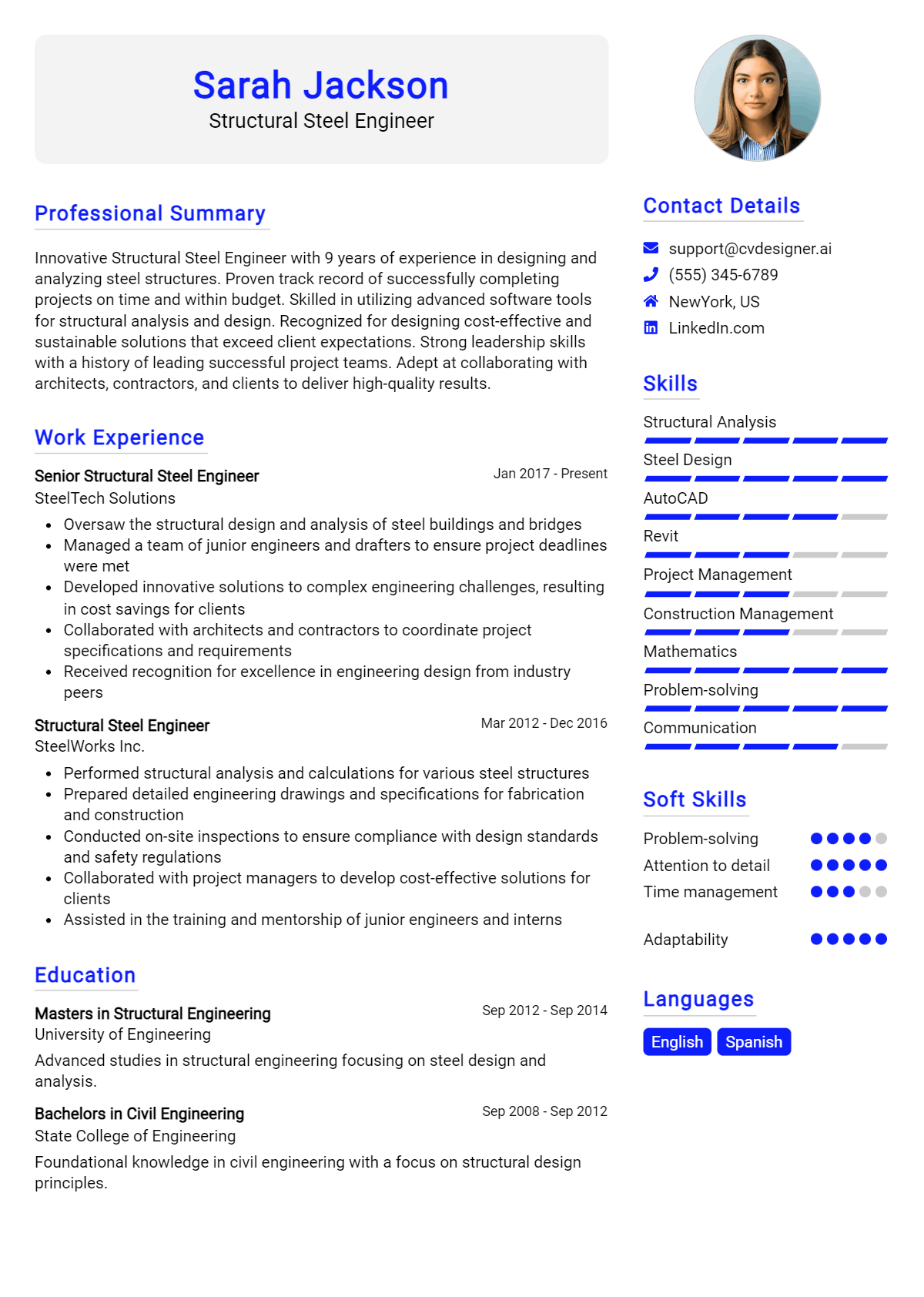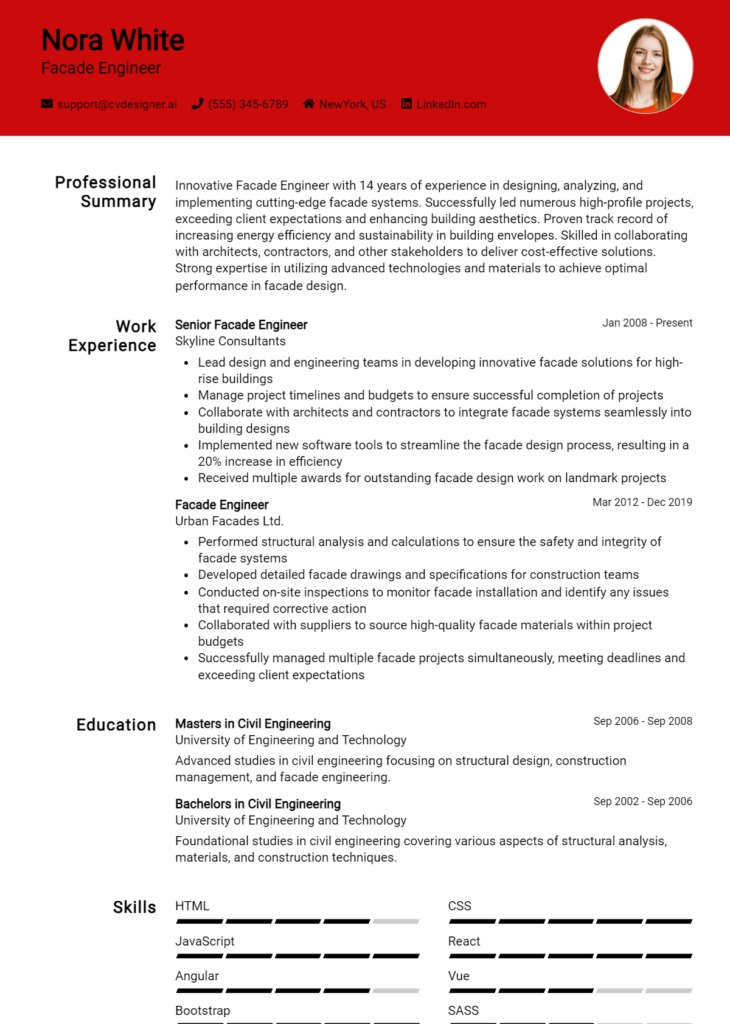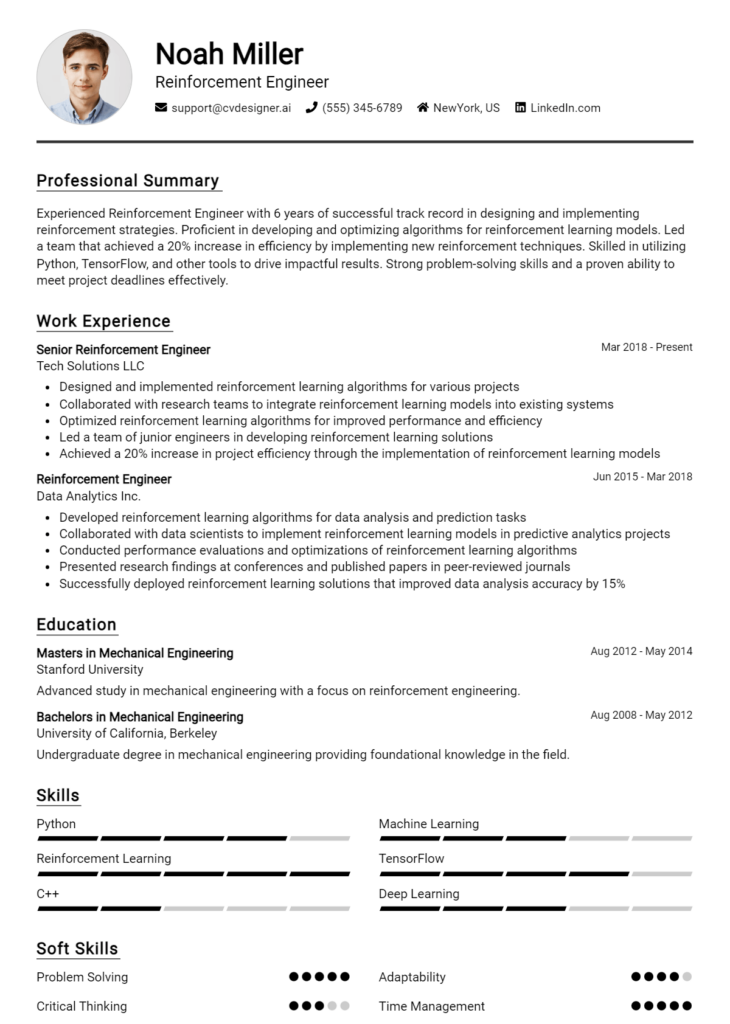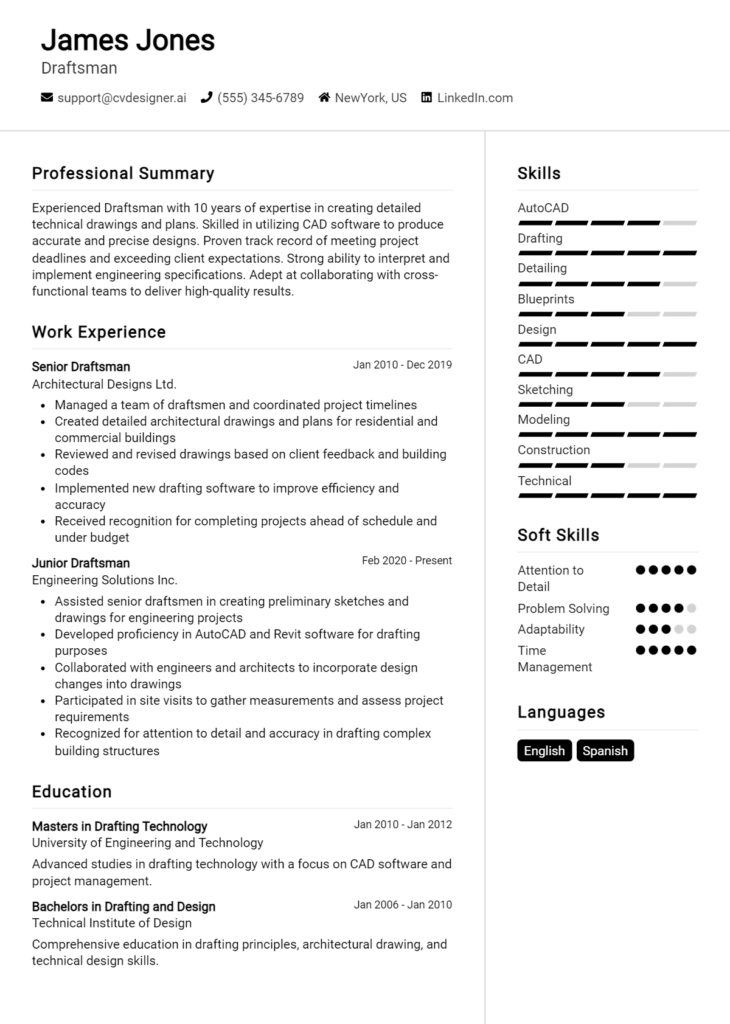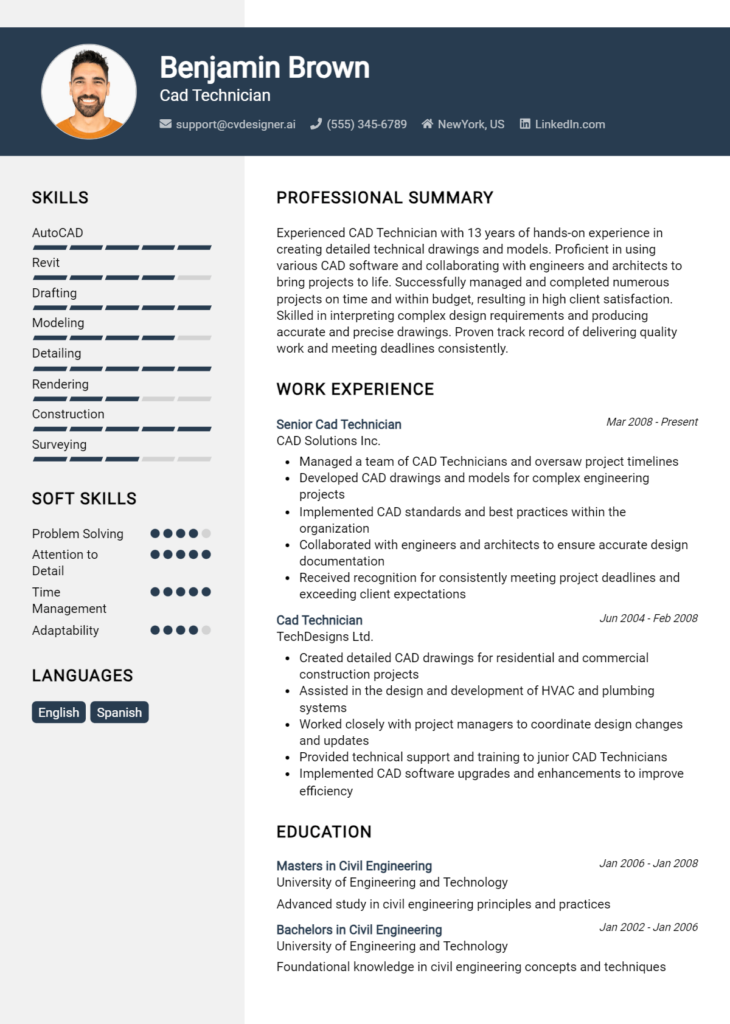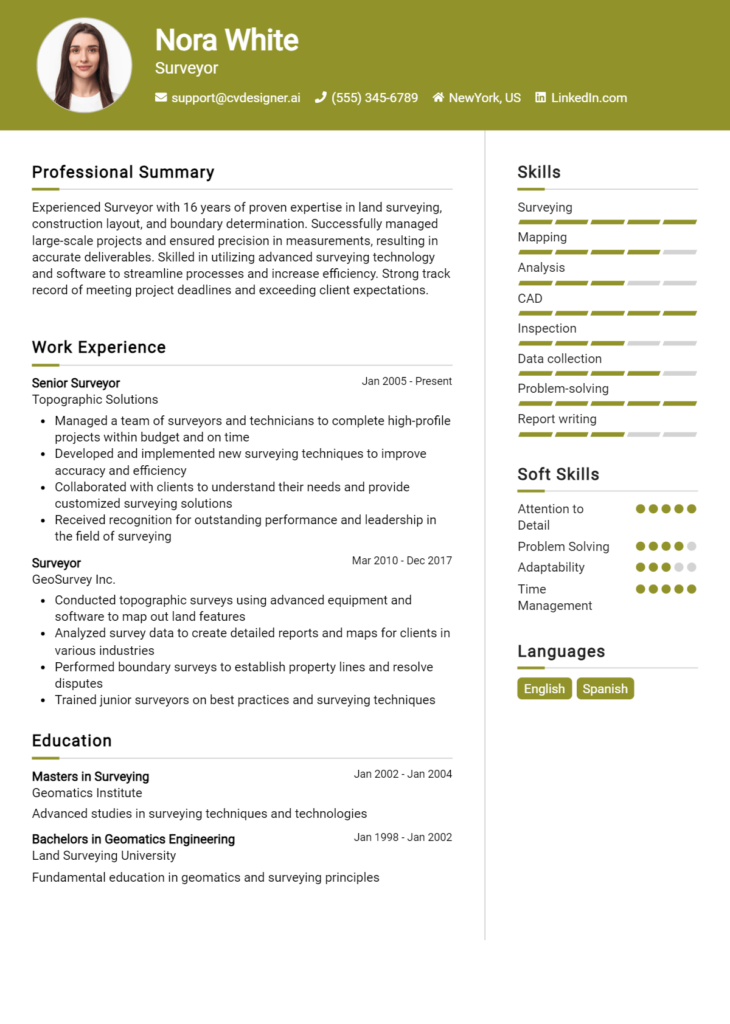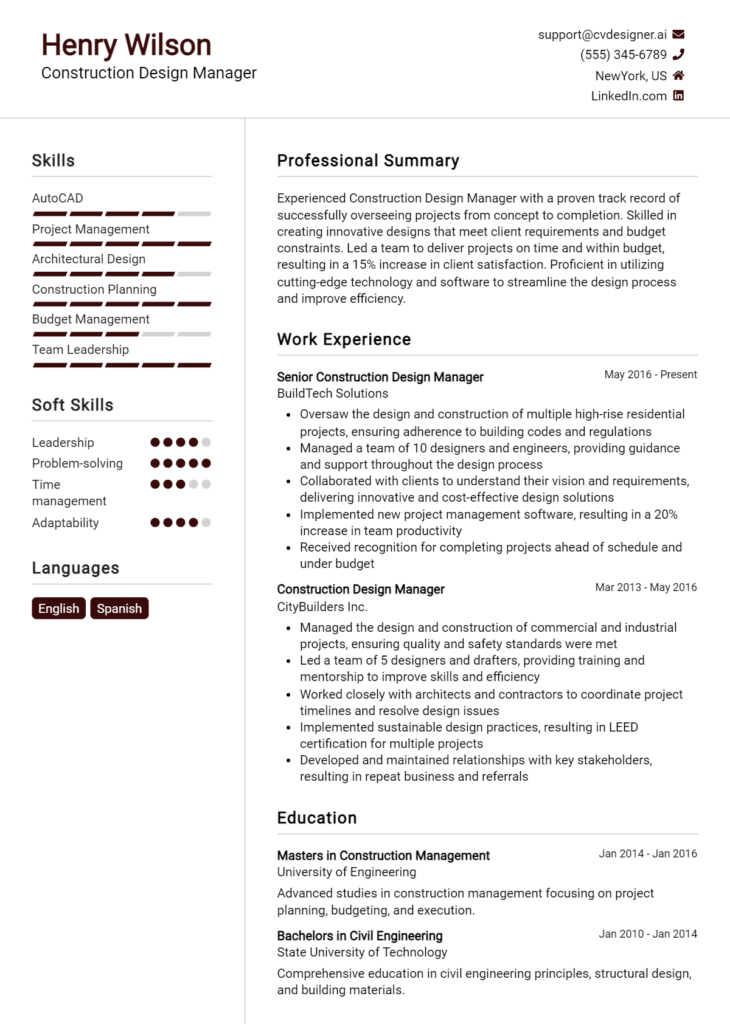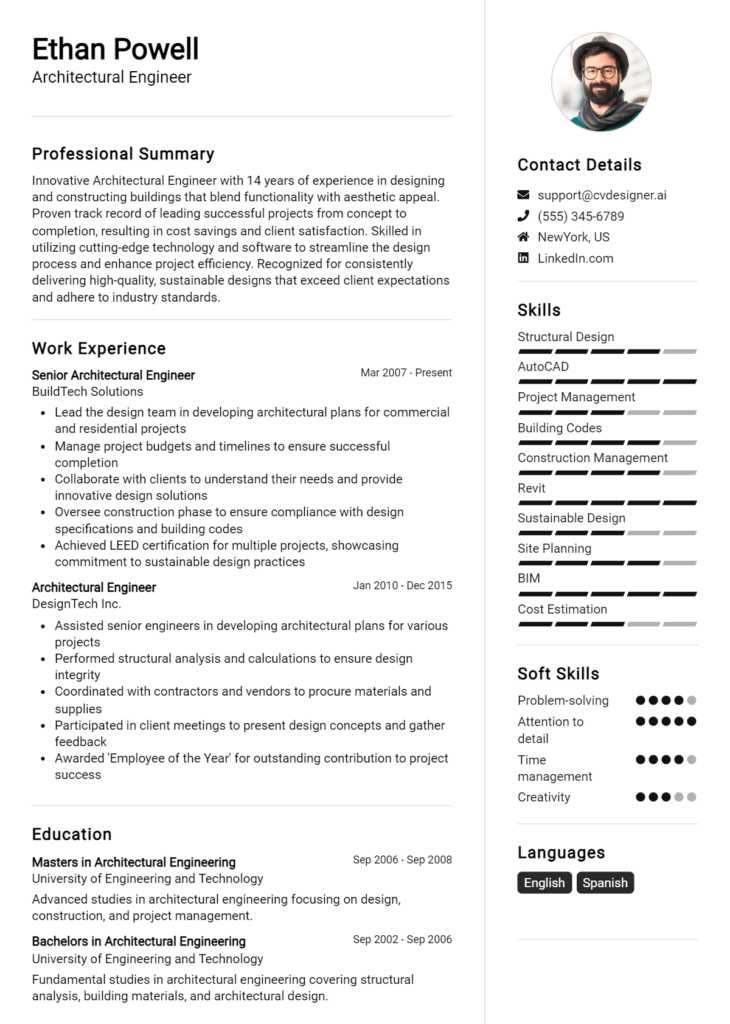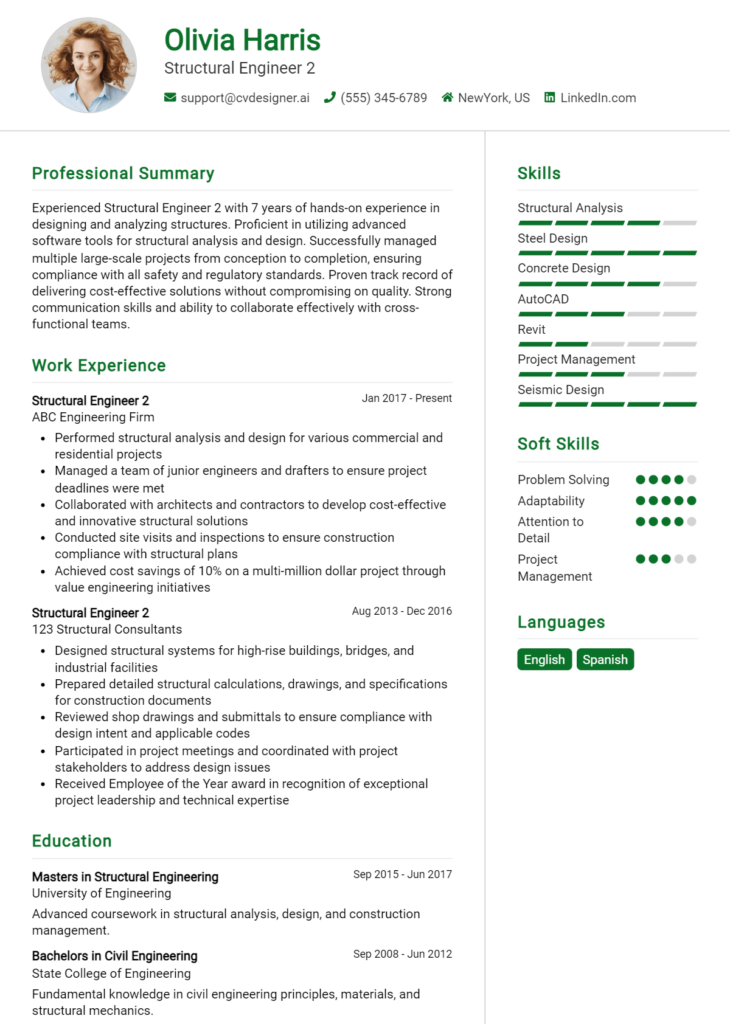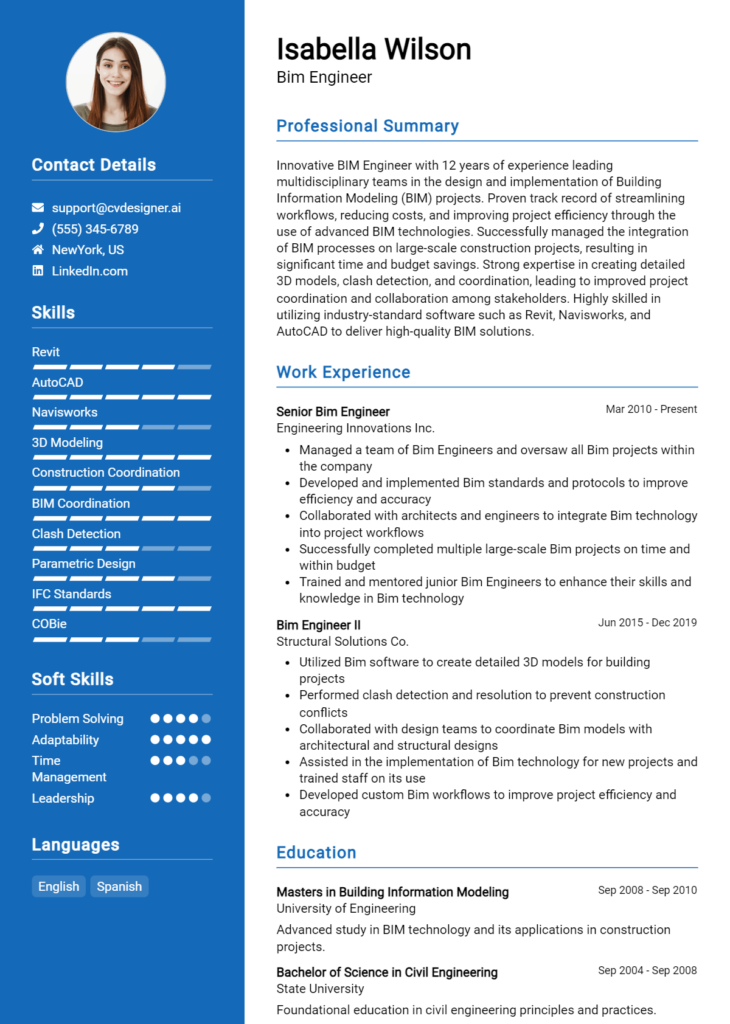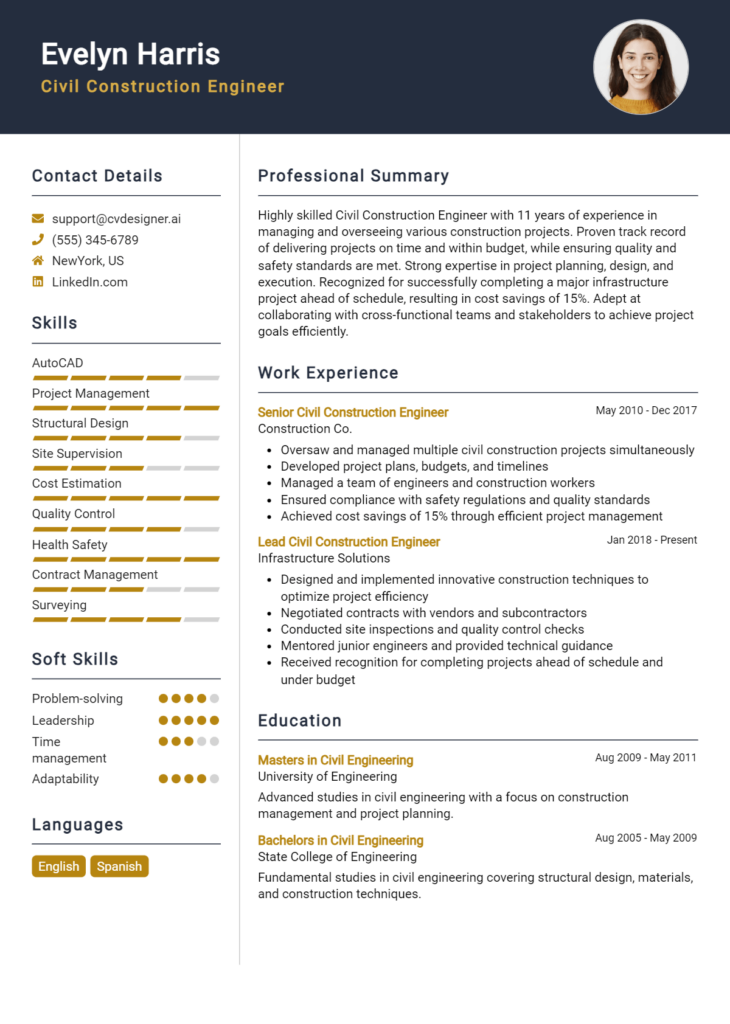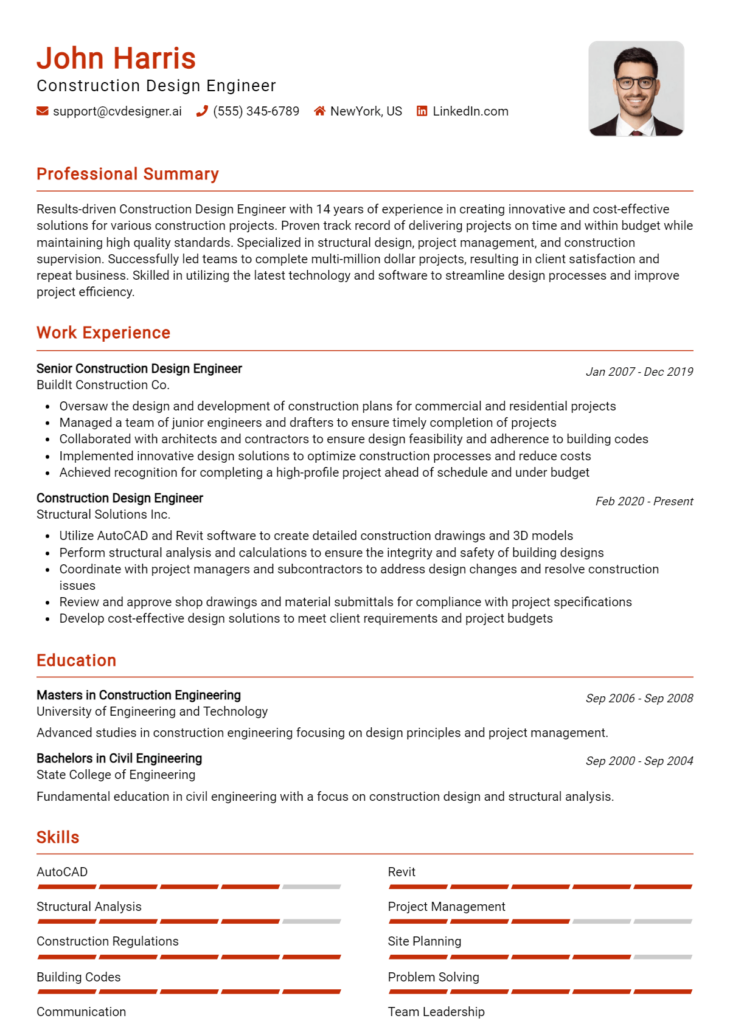Structural Steel Engineer Core Responsibilities
A Structural Steel Engineer plays a crucial role in design, analysis, and oversight of steel structures, ensuring safety and compliance with regulations. This position requires strong technical expertise in structural engineering, operational knowledge of construction processes, and exceptional problem-solving skills to address complex challenges. By collaborating with architects, contractors, and project managers, the engineer bridges multiple departments, aligning project goals with organizational objectives. A well-structured resume can effectively showcase these qualifications, highlighting the candidate's ability to contribute to successful project outcomes.
Common Responsibilities Listed on Structural Steel Engineer Resume
- Design and analyze structural steel frameworks and components.
- Prepare detailed engineering drawings and specifications.
- Conduct structural assessments and evaluations for compliance.
- Collaborate with architects and construction teams on project plans.
- Ensure adherence to safety standards and building codes.
- Manage project timelines and budgets effectively.
- Provide technical guidance and support during construction.
- Perform load calculations and simulations to optimize designs.
- Review and approve shop drawings and fabrication details.
- Conduct site inspections to monitor construction progress.
- Identify and resolve design and construction-related issues.
- Stay updated on industry trends and advancements in materials.
High-Level Resume Tips for Structural Steel Engineer Professionals
For Structural Steel Engineer professionals, a well-crafted resume is not just a document; it's a vital marketing tool that can make or break your job application. Your resume is often the first impression a potential employer has of you, and it needs to effectively convey your technical skills, relevant experience, and notable achievements in the field. A strong resume reflects your qualifications and demonstrates your understanding of the structural steel industry, allowing you to stand out in a competitive job market. This guide will provide practical and actionable resume tips specifically tailored for Structural Steel Engineer professionals, helping you to present yourself in the best possible light.
Top Resume Tips for Structural Steel Engineer Professionals
- Tailor your resume to each job description by incorporating keywords and phrases that match the specific requirements of the position.
- Highlight relevant work experience by emphasizing projects where you played a key role in steel structure design, fabrication, or erection.
- Quantify your achievements by using metrics, such as the percentage of cost savings you achieved or the square footage of structures you designed.
- Showcase industry-specific skills, including proficiency with software like AutoCAD, SAP2000, and Revit, and highlight any certifications or licenses you hold.
- Include a dedicated section for professional development, outlining relevant training, workshops, or conferences you have attended.
- Use a clean, professional format with consistent font and spacing to enhance readability and make a strong visual impression.
- Incorporate a summary statement at the top of your resume that encapsulates your experience and career goals in structural steel engineering.
- List any leadership roles or teamwork experiences that demonstrate your ability to collaborate with architects, contractors, and other engineers.
- Be concise and focused; aim to keep your resume to one or two pages while ensuring all critical information is included.
By implementing these tips, you can significantly enhance your resume, increasing your chances of landing a job in the Structural Steel Engineer field. A compelling resume that effectively communicates your qualifications will not only capture the attention of hiring managers but also position you as a strong candidate ready to contribute to any engineering team.
Why Resume Headlines & Titles are Important for Structural Steel Engineer
In the competitive field of structural engineering, a well-crafted resume headline or title is essential for standing out among a pool of applicants. For a Structural Steel Engineer, the headline serves as the first impression and should encapsulate the candidate's key qualifications and expertise in a concise and impactful manner. A strong headline can immediately grab the attention of hiring managers, providing a snapshot of the candidate's professional identity and relevance to the job being applied for. It sets the tone for the rest of the resume, making it crucial for candidates to tailor their headlines to reflect their skills and experience directly related to structural steel engineering.
Best Practices for Crafting Resume Headlines for Structural Steel Engineer
- Keep it concise: Aim for no more than 10-12 words.
- Be specific: Use language that reflects the structural steel engineering field.
- Highlight key skills: Incorporate technical skills relevant to the position.
- Showcase years of experience: Mention your expertise level if significant.
- Use action-oriented language: Start with strong verbs to convey impact.
- Customize for each application: Tailor the headline to match the job description.
- Include relevant certifications: Mention any pertinent qualifications or licenses.
- Reflect your career goals: Indicate your aspirations where appropriate.
Example Resume Headlines for Structural Steel Engineer
Strong Resume Headlines
Innovative Structural Steel Engineer with 10+ Years of Experience in High-Rise Construction
Detail-Oriented Steel Design Specialist Skilled in Advanced CAD Applications
Licensed Professional Engineer Focused on Sustainable Steel Structures and Safety Compliance
Results-Driven Structural Engineer with Proven Expertise in Project Management and Cost Optimization
Weak Resume Headlines
Engineer with Some Experience
Seeking Engineering Position
Strong resume headlines are effective because they provide specific insights into the candidate's experience, skills, and achievements, instantly conveying their value to potential employers. They not only capture attention but also create a sense of professionalism and purpose. In contrast, weak headlines lack specificity and fail to communicate relevant qualifications, making it challenging for hiring managers to gauge the applicant's suitability for the role. This often leads to the candidate being overlooked in favor of those with more compelling and tailored headlines.
Writing an Exceptional Structural Steel Engineer Resume Summary
A well-crafted resume summary is crucial for a Structural Steel Engineer as it serves as the first impression a hiring manager receives. This brief yet impactful introduction quickly highlights the candidate's key skills, relevant experience, and notable accomplishments, making it easier for employers to assess fit for the role. A strong summary should be concise, impactful, and tailored specifically to the job description, ensuring that it captures attention and sets the tone for the rest of the resume.
Best Practices for Writing a Structural Steel Engineer Resume Summary
- Quantify Achievements: Use numbers to demonstrate the impact of your work, such as project sizes, budgets managed, or timelines met.
- Focus on Relevant Skills: Highlight technical skills such as AutoCAD, structural analysis, and project management that align with the job requirements.
- Tailor for the Job Description: Customize your summary for each application by reflecting the specific responsibilities and qualifications listed in the job posting.
- Be Concise: Aim for 3-5 sentences that deliver your key points without unnecessary jargon or fluff.
- Showcase Problem-Solving Abilities: Highlight experiences where you've successfully addressed challenges in structural engineering projects.
- Incorporate Industry Keywords: Utilize terms and phrases commonly found in the structural engineering field to enhance your visibility in applicant tracking systems.
- Reflect Professional Growth: Indicate your career progression and continuous learning in the field of structural engineering.
- Use Action Verbs: Start sentences with strong action verbs to convey a sense of proactivity and achievement.
Example Structural Steel Engineer Resume Summaries
Strong Resume Summaries
Results-driven Structural Steel Engineer with over 8 years of experience in designing and implementing high-rise building projects, successfully managing budgets exceeding $5 million and reducing project timelines by 20% through effective resource allocation.
Detail-oriented Structural Steel Engineer adept at utilizing AutoCAD and SAP2000 for innovative structural designs, having led a team to complete a $10 million bridge project 3 months ahead of schedule while ensuring compliance with safety regulations.
Dynamic Structural Steel Engineer with a proven track record of reducing material costs by 15% through strategic supplier negotiations and efficient design methodologies, contributing to the successful completion of over 25 large-scale industrial projects.
Weak Resume Summaries
Experienced engineer with a background in steel structures looking for a new opportunity.
Structural engineer with some experience in project management and design, seeking to apply skills in a new role.
The examples above illustrate the distinction between strong and weak resume summaries. The strong summaries effectively quantify achievements, showcase relevant skills, and demonstrate a direct connection to the role, making them compelling to hiring managers. In contrast, the weak summaries are vague, lack specific accomplishments, and do not convey the candidate's value or relevance to the position, which diminishes their impact.
Work Experience Section for Structural Steel Engineer Resume
The work experience section of a Structural Steel Engineer resume is crucial as it provides potential employers with a clear understanding of the candidate's technical expertise, project management capabilities, and ability to lead teams in delivering high-quality structural solutions. This section serves to highlight not only the specific skills developed through hands-on experience but also the tangible outcomes achieved in previous roles. Quantifying achievements, such as project efficiencies or cost savings, and aligning experiences with industry standards are essential for demonstrating one’s value in the competitive field of structural engineering.
Best Practices for Structural Steel Engineer Work Experience
- Detail specific technical skills relevant to structural steel design and analysis.
- Quantify achievements, such as percentage of cost savings or project completion times.
- Highlight leadership roles in team projects, emphasizing collaboration and communication skills.
- Use industry-standard terminology to align your experience with employer expectations.
- Provide examples of successful project management, including timelines and budget adherence.
- Include certifications and training that enhance your technical qualifications.
- Demonstrate problem-solving skills by outlining challenges faced and solutions implemented.
- Tailor your experiences to the specific job description to increase relevance and impact.
Example Work Experiences for Structural Steel Engineer
Strong Experiences
- Led a team of engineers in the design and fabrication of a 200,000 sq. ft. commercial building, achieving a 15% reduction in overall costs through optimized material selection and innovative design approaches.
- Managed the structural analysis and design for a high-rise project, ensuring compliance with local building codes and reducing project timelines by 20% through effective resource allocation.
- Collaborated with architects and contractors on a bridge construction project, facilitating seamless communication that resulted in zero safety violations and on-time project delivery.
Weak Experiences
- Worked on various structural projects, assisting in general engineering tasks.
- Participated in team meetings and contributed to project discussions.
- Helped with the design of structures with limited involvement.
The examples listed as strong experiences are considered impactful because they clearly articulate specific achievements, quantify results, and demonstrate leadership and collaboration within a team, showcasing the candidate's ability to drive successful outcomes. In contrast, the weak experiences lack detail and measurable impact, making them less compelling to potential employers. Providing vague descriptions without quantifiable results diminishes the perceived value of the candidate's contributions in previous roles.
Education and Certifications Section for Structural Steel Engineer Resume
The education and certifications section of a Structural Steel Engineer resume is crucial in establishing the candidate's qualifications and expertise in the field. This section serves as a testament to the individual’s academic background, showcasing relevant degrees and coursework that provide foundational knowledge in structural engineering principles. Additionally, industry-relevant certifications demonstrate a commitment to professional development and adherence to the latest standards and practices. By including specialized training and certifications, candidates can significantly enhance their credibility, making them more appealing to potential employers who seek professionals capable of addressing complex structural challenges.
Best Practices for Structural Steel Engineer Education and Certifications
- Prioritize degrees in civil or structural engineering, clearly stating the institution and graduation date.
- List industry-recognized certifications, such as the Professional Engineer (PE) license, prominently.
- Include relevant coursework that directly pertains to structural steel design and analysis.
- Highlight any specialized training in software tools commonly used in structural engineering, like AutoCAD or SAP2000.
- Use clear and concise formatting to enhance readability and ensure quick access to key information.
- Regularly update this section to reflect new certifications or courses completed, demonstrating continuous learning.
- Consider including honors or awards related to engineering or project management to further bolster your qualifications.
- Tailor this section to match the specific job description, emphasizing the most relevant credentials for each application.
Example Education and Certifications for Structural Steel Engineer
Strong Examples
- Bachelor of Science in Civil Engineering, University of XYZ, Graduated May 2020
- Professional Engineer (PE) License, State of ABC, Issued January 2021
- Certification in Structural Steel Design, National Institute of Steel Construction, Completed June 2022
- Advanced Structural Analysis Coursework, University of XYZ, Completed December 2019
Weak Examples
- Bachelor of Arts in History, University of DEF, Graduated May 2015
- Basic First Aid Certification, Red Cross, Completed March 2021
- Online Course in Creative Writing, Coursera, Completed August 2020
- Certification in Microsoft Office Suite, Issued April 2019
The strong examples listed above are relevant and aligned with the requirements of a Structural Steel Engineer, showcasing pertinent degrees, recognized certifications, and coursework directly applicable to the role. In contrast, the weak examples fail to demonstrate relevant qualifications for the engineering field, highlighting degrees and certifications that do not contribute to the candidate's competence as a Structural Steel Engineer. This distinction underscores the importance of including only pertinent educational achievements and certifications that enhance one’s professional profile.
Top Skills & Keywords for Structural Steel Engineer Resume
As a Structural Steel Engineer, your resume is not just a list of past experiences; it is a reflection of your technical expertise and interpersonal abilities. The importance of including relevant skills cannot be overstated, as they serve to showcase your qualifications to potential employers and differentiate you from other candidates. A well-crafted resume highlights both hard and soft skills, demonstrating your ability to work effectively in a team while also possessing the technical knowledge required for the role. By emphasizing these skills, you provide a comprehensive view of your capabilities and readiness to tackle the challenges faced in structural engineering projects.
Top Hard & Soft Skills for Structural Steel Engineer
Soft Skills
- Communication
- Team Collaboration
- Problem-Solving
- Time Management
- Attention to Detail
- Critical Thinking
- Adaptability
- Leadership
- Conflict Resolution
- Project Management
Hard Skills
- Structural Analysis
- Proficiency in CAD Software (AutoCAD, Revit)
- Knowledge of Building Codes and Regulations
- Steel Fabrication Techniques
- Load Calculations
- Material Properties Understanding
- Welding and Joining Techniques
- Construction Project Management
- Risk Assessment
- Quality Assurance and Control
By integrating these essential skills into your resume, you can effectively communicate your suitability for the Structural Steel Engineer position. Furthermore, don't forget to supplement your skills with relevant work experience that illustrates your expertise in action.
Stand Out with a Winning Structural Steel Engineer Cover Letter
Dear [Hiring Manager's Name],
I am writing to express my interest in the Structural Steel Engineer position at [Company Name], as advertised on [where you found the job listing]. With a Bachelor’s degree in Civil Engineering and over [X years] of hands-on experience in structural steel design and analysis, I am confident in my ability to contribute effectively to your team. My expertise lies in creating efficient and innovative designs that adhere to safety standards while optimizing material use.
In my previous role at [Previous Company Name], I successfully led a team of engineers in the design and execution of several large-scale projects, including [specific project or type of project]. My responsibilities included conducting structural analyses, developing detailed design documentation, and collaborating with architects and contractors to ensure seamless project delivery. I pride myself on my ability to communicate complex engineering concepts clearly, which has proven essential in fostering strong interdisciplinary collaboration and minimizing project delays.
I am particularly drawn to [Company Name] because of its commitment to innovation and excellence in engineering. I admire your recent projects such as [specific project], which exemplify cutting-edge design and sustainability. I am eager to bring my skills in structural modeling software, project management, and code compliance to your esteemed company, contributing to projects that push the boundaries of modern engineering.
Thank you for considering my application. I look forward to the opportunity to discuss how my background, skills, and enthusiasms align with the goals of [Company Name]. I am excited about the possibility of joining your team and contributing to the success of your projects.
Sincerely,
[Your Name]
[Your Contact Information]
[LinkedIn Profile or Portfolio URL, if applicable]
Common Mistakes to Avoid in a Structural Steel Engineer Resume
When crafting a resume for a Structural Steel Engineer position, it's crucial to present your skills and experiences clearly and effectively. However, many candidates make common mistakes that can undermine their qualifications and reduce their chances of landing an interview. Avoiding these pitfalls can significantly enhance the quality of your resume and increase your chances of standing out to potential employers.
Generic Objective Statement: Using a vague or generic objective statement fails to tailor your resume to the specific job, making it less impactful. Instead, focus on a clear, targeted statement that reflects your career goals and aligns with the job description.
Neglecting Relevant Skills: Omitting key skills relevant to structural steel engineering, such as proficiency in software like AutoCAD or understanding of building codes, can lead to missed opportunities. Always highlight skills that directly relate to the job requirements.
Too Much Technical Jargon: While technical terms are important in engineering, overloading your resume with jargon can make it difficult for non-technical HR personnel to understand your qualifications. Strike a balance by using clear language while still showcasing your expertise.
Lack of Quantifiable Achievements: Failing to include quantifiable achievements can make your resume less compelling. Use metrics and specific examples to demonstrate your contributions, such as "designed steel structures that reduced costs by 15%".
Ignoring Formatting and Readability: A cluttered or poorly formatted resume can be off-putting to employers. Use consistent formatting, bullet points, and clear headings to enhance readability and ensure that your key points stand out.
Excessive Length: Including irrelevant information or making your resume longer than necessary can dilute its impact. Aim for a concise, one-page resume that highlights your most relevant experiences and skills.
Not Tailoring to Job Descriptions: Submitting a one-size-fits-all resume without tailoring it to the specific job description can be detrimental. Carefully read each job posting and adjust your resume to reflect the qualifications and experiences that are most relevant to that particular role.
Omitting Professional Development: Neglecting to include certifications, training, or ongoing education can give the impression that you are not committed to staying current in your field. Highlight any relevant courses, certifications, or workshops that demonstrate your commitment to professional growth.
Conclusion
As a Structural Steel Engineer, your expertise plays a crucial role in designing and overseeing the construction of steel structures. Throughout this article, we have highlighted the essential skills and qualifications needed in this field, including a strong understanding of engineering principles, proficiency in structural analysis software, and an awareness of safety regulations. Additionally, we explored the importance of effective communication and teamwork in collaborating with architects, contractors, and other engineers to ensure project success.
In conclusion, to stand out in the competitive job market, it's vital to have an impressive resume that clearly showcases your skills and experiences. We encourage you to take the time to review and update your Structural Steel Engineer resume, ensuring it reflects your qualifications and accomplishments accurately.
To assist you in this process, explore the variety of resources available, such as resume templates, which can help you create a polished and professional resume. You can also utilize the resume builder for a more customized approach, or refer to resume examples tailored specifically for Structural Steel Engineers. Don’t forget to craft a compelling introduction with our cover letter templates. Take action today and ensure your resume is ready to capture the attention of potential employers!

